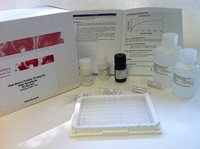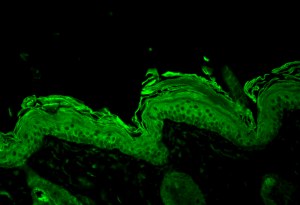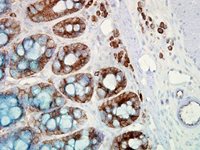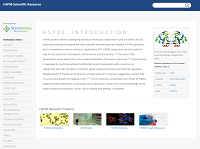HSP90 Resource Guide
HSP90 Resources
 HSP90 Alpha StressXpress® ELISA Kit |
 HSP90 Antibody, Polyclonal |
 HSP90 Antibody, Clone H9010 |
 HSP90 Scientific Resource Guide |
Hsp90 is one of a number of classes of heat shock proteins (Hsps), which are generally synthesized in response to cellular stress as well as being constitutively expressed in some cases. These types of stress are numerous, but include heat shock, metal toxicity, nutrient deprivation, oxidative stress as well as numerous disease states of which cancer has received the most attention.
Product and Research Area Links
Hsps function is several ways, but have the ability to form complexes with client proteins and act as molecular chaperones. These complexes are themselves directly involved in protein folding in the cytosol, endoplasmic reticulum (ER) and mitochondria, the intracellular transport of proteins, protein repair and degradation (of environmentally damaged proteins), regulatory protein control, and the re-folding of misfolded proteins. The Hsps have been generally classified into several classes depending on their molecular weights, see Table 1. Hsp90 is one of the most prevalent chaperone proteins present in the cell -it can represent 1-2% of unstressed cell’s protein and as much as 6% in the stressed cell. It has the ability to provide multi-component complexes which have been shown to include p60/Hop, p50Cdc37, Hsp40/HDJ2, p23, Hsp70 and one of a number of immunophilins (such as FKBP51 and FKBP52).
Table 1*.
| Protein Name | Localization | Function |
|---|---|---|
| Hsp104 | Cytoplasm | Releases proteins from aggregates |
| Hsp90α and Hsp90ß | Cytoplasm | Prevents protein aggregation, enables protein stabilization and trafficking, facilitates activation of numerous regulated proteins |
| Grp94 | Endoplasmic reticulum | Quality control of protein processing in the endoplasmic reticulum |
| TRAP / Hsp25 | Mitochondria | Unclear |
| Hsp70 / Hsc70 | Cytoplasm | Prevents protein aggregation, aids protein folding |
| Grp78 / Bip | Endoplasmic reticulum | Protein import and folding in the endoplasmic reticulum |
| Hsp60 / Chaperonins | Cytoplasm and mitochondria | Prevents protein aggregation, aids protein folding |
| Hsp47 | Endoplasmic reticulum | Facilitates the folding and assembly of procollagen molecules, retaining unfolded molecules within the ER, and assisting the transport of correctly folded molecules from the ER to the Golgi apparatus. |
| Hsp40 / HDJ2 | Cytoplasm | Helps protein folding as a co-chaperone of hsp70 |
| Hsp32 (HO-1; small Hsps) | Endoplasmic reticulum, plasma membrane and mitochondria | Catalyzes first step of heme degradation to bilirubin, which has antioxidant properties. |
| Hsp27 / Hsp25 (small Hsps) | Endoplasmic reticulum | Prevents protein aggregation, may have role in cell growth and differentiation |
| Alpha B crystallin (small Hsps) | Cytoplasm | Major eye lens protein. Alpha B-crystallin inhibits TRAIL induced apoptosis in cancer. It confers a cytoprotective effect by suppressing aggregation of denatured proteins. It is constitutively expressed, often at high levels, in human cancers, including gliomas, breast, prostate and renal cell carcinomas. |
* Adapted from Annals in Oncology, 14: 1169-1176, 2003
Hsp90 itself is present in two forms, Hsp90α and ß. Both proteins are highly related and appear to have identical activities, however, the former is inducible whereas the latter is constitutively expressed. Hsp90 is also a phospho-protein -and has two or tree bound phosphate molecules per monomer and exists as a homodimer. One of the clear distinctions that have made it a potential drug target are the fact that a significant amount of it’s client proteins are protein kinases. These client proteins include ErbB2/Her-2, EGFR, Hif1α, c-Met, Akt/PKB, Raf-1, Cdk-1 and 4, Aurora B, Ask1, CHK1, CKII as well as mutant p53. Furthermore, due to the nature of the interactive and complex network that is associated with regulating cell proliferation and cell death, the approach of identifying one specific (drug) target and blocking or activating it can result in the cell simply altering it’s regulation in order to maintain the phenotype. The wide amount of Hsp90 client proteins and the fact that many of them are directly involved in regulatory (signaling and phosphorylation) processes have allowed researchers to take a wider target approach to shutting down activities associated with cancers and stepping around the redundancies of the multiple signaling routes.
Hsp90 has been widely studied in relation to steroid receptors, despite the first recognized substrate being discovered to be pp60v-sr. These studies have elucidated that the receptors must be bound to Hsp90 to have a high binding affinity for steroids. The Hsp90 assembly also showed the importance of the presence of p23 and Hop, working together with Hsp70 and Hsp90 as a multi-protein machine. Together with Hsp40, these five protein work together to produce receptor-Hsp90 heterocomplexes with steroid-binding activity. Mechanistic studies have indicated the steps involved in the assembly, strating with two sequential ATP-dependent events involving first hsp70 and then hsp90. Interestingly, since the chaperone machinery reveals a hydrophobic steroid-binding cleft to access the ligand, the action of Hsp90 as part of the multiprotein machinery is quite different from that of hsp90 acting alone in vitro to promote reactivation of partially denatured enzymes. The three hsp90-binding TPR domain immunophilins -FKBP52, FKBP51, and CyP-40-were discovered as components of steroid receptor-hsp90 heterocomplexes.
Steroid-mediated glucocorticoid receptor translocation from the cytoplasm to the nucleus has led to the discovery that the TPR domain immunophilins link Hsp90 to a dynein motor protein. The mechanistic conclusions derived from elucidation of how the Hsp90 machinery works with the steroid receptor appear to be provide a broad set of principles of how Hsp90 works, which would be in contrast to other cell stress protein chaperone studies. The latter would indicate that in order to be a substrate for Hsp90 or Hsp70 the presence of (some degree of) unfolded protein would be required -however there have been no indications for the steroid receptor studies that receptors are in any way denatured. When Hsp90 and Hsp70 act together a highly focal site of attack is located on the glucocorticoid receptor that is situated on the surface of the ligand-binding domain at the opening of the hydrophobic steroid-binding cleft. However, whether or not Hsp90 has the general ability to recognize cleft openings on other signaling proteins is unclear, but due to the fact that they are present on almost all protein as a topological feature it is possible that the Hsp90 and Hsp70 complex recognizes these native rather than denatured conformations.
Currently, high interest has been manifest in benzoquinone ansamycin antibiotics (BA), which include herbimycin, geldanamycin and 17-allylamino-17-demethoxygeldanamycin (17-AAG), a drug class capable of affecting multiple targets in tumor cell pathways by binding to Hsp90. 17AAG has also been modified to make 17-dimethylaminoethylamino -7 demethoxygeldanamycin (17-DMAG) to improve drug half-life and water solubility. These drugs bind Hsp90 at a conserved 25kD N-terminal domain which is responsible for ATP binding, hence disrupting the Hsp90 chaperone complex. Other inhibitors include radicicol, the chemotherapeutic agent cisplatin, taxol, as well as the antibactericidal novobiocin. Cisplatin binds to a novel nucleotide-binding site of Hsp90 at its C-terminus, while novobiocin binds to several domains of Hsp90. This leads directly to the disruption of the Hsp90 activity and the chaperone complex functions, resulting in depletion of the oncogenic client proteins.
